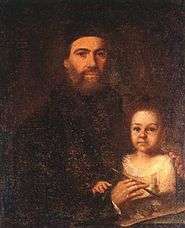Nikolaos Kantounis


(late 18th century)
Nikolaos Kantounis (Greek: Νικόλαος Καντούνης; 1767, Zakynthos – 1834, Zakynthos) was a Greek painter; he was one of the most important representatives of the Heptanese School.
Biography
His father was a physician and amateur poet. Although some sources say that he was entirely self-taught (and Kantounis asserted that himself),[1] it is believed that he received drawing lessons from a local artist named Ioannis Korais (died 1786) and worked in the studios of Nikolaos Koutouzis; who is rumored to have expelled him out of jealousy.[2]
In 1786, he was also ordained a priest and later became a member of the Filiki Eteria (Society of Friends),[2] dedicated to overthrowing Ottoman rule. As a result of his subversive actions, the British exiled him to the island of Kyra, near Cephalonia.[1] He was able to return home after the recognition of Greek independence in 1832.
Some of his most important church decorations on Zakynthos were later destroyed by earthquakes.[2] His icons have been preserved in the local museum. Although he was an Orthodox priest, his works owe more to Western artistic traditions. He also painted many portraits of secular figures and took an occasional student; most notably Gerasimos Pitzamanos and Dionysios Tsokos, one of the last members of the Heptanese School.[1]
References
- 1 2 3 Brief biography @ Ygeia Online.
- 1 2 3 Brief biography @ the National Gallery of Greece.
External links
![]()
- More paintings by Kantounis @ the "ΠΕΡΙ ΤΕΧΝΗΣ Ο ΛΟΓΟΣ" blog.